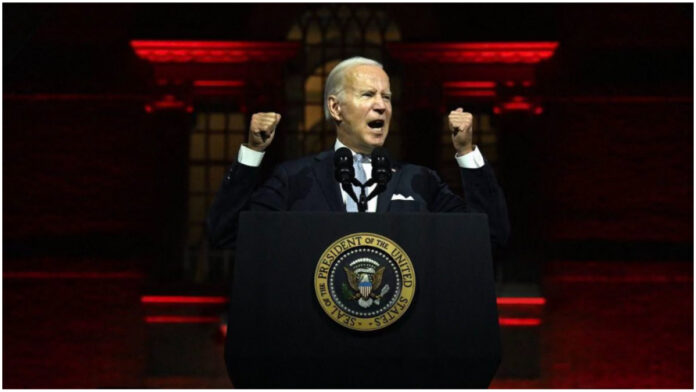President Joe Biden touted falling food prices Thursday, but the latest federal data shows the price of food is actually on the rise and has been for more than a year.
The U.S. Bureau of Labor Statistics released new inflation data Thursday that showed the overall consumer price index dropped 0.1%, driven in part by a decrease in energy prices.
“For the sixth month in a row, yearly inflation is down,” Biden wrote on Twitter after BLS released the data. “It might be rising in economies around the world, but it’s coming down here. And gas prices, food, and more are following. That adds up to a break for families and proof that my plan is working.”
While prices overall dropped, food prices actually rose in December.
“The food index increased 0.3 percent over the month [of December] with the food at home index rising 0.2 percent,” BLS said.
After the tweet, Biden acknowledged in a speech Thursday that food prices did rise in December, but lauded the slower increase.
BLS data shows the “food at home” index rose 0.2% in December and 11.8% in the past year. Food away from home rose 0.4% in December and 8.3% in the last year.
“The index for cereals and bakery products rose 16.1 percent over the year. The remaining major grocery store food groups posted increases ranging from 7.7 percent (meats, poultry, fish, and eggs) to 15.3 percent (dairy and related products),” BLS said.
Some categories did see decreases, and the data fluctuates month to month, but overall the price of food rose in December.
From BLS’ data, here are some seasonally adjusted price changes for urban consumers for the major food categories in December as well as the annual numbers:
- Cereals and bakery products prices saw no change in December but rose 16.1% in the last year.
- Meats, poultry, fish, and eggs rose 1% in December and 7.7% in the last year.
- Dairy and related products prices declined 0.3% in December but rose 15.3% in the last year.
- Fruits and vegetable prices declined 0.6% in December but rose 8.4% in the last year.
- Nonalcoholic beverages and beverage materials prices rose 0.1% in December and 12.4% in the last year.
- BLS’ “other food at home” category saw a 0.4% increase in December and a 13.9% increase in the last year.
Overall, these figures are much higher than when Biden took office, since prices had largely already begun rising before this time last year on a range of goods and services, including food.
While food prices have increased, they are rising at a slower rate than months prior.
“CPI inflation slowed sharply at year-end as consumers got relief from lower gasoline prices, and prices of most foods rose more slowly,” said Bill Adams, chief economist for Comerica Bank. “Comerica forecasts a mild recession in 2023, fueled by surging interest rates, the housing correction, households tightening belts in the face of higher inflation, and businesses adding more carefully to inventories as demand slows. The unemployment rate will likely rise by about a percentage point by the end of this year.”
Biden has repeatedly blamed Russian President Vladimir Putin’s invasion of Ukraine for higher food prices.
As The Center Square previously reported, Ukraine is a major food producer as well as a major exporter of key ingredients in fertilizer. The invasion has hurt food production and tied up the supply chain, making food and the fertilizer that helps it grow significantly more expensive.
“The two challenges on the minds of most working families are prices at the pump and prices at the grocery store,” Biden said during remarks in June of last year, the same month gas prices set records with a national average price over $5 per gallon. “Both of these challenges have been directly exacerbated by Putin’s war in Ukraine.”
Experts agree the invasion “exacerbated” the problem, but prices, including food prices, were already rising quickly before Russia invaded Ukraine.
In the middle of February, about two weeks before Russia invaded Ukraine, BLS released consumer price index data showing food prices had already risen significantly.
That data showed that “food at home” prices had risen 7.4% in the previous 12 months. Economists say about 2% inflation annually is a good increase for a healthy economy.
The meat, poultry, fish and eggs category rose 12.2% in that data. An avian flu outbreak also contributed to rising prices recently.
Republicans have continued to attack Biden for the higher prices.
“It’s time for Congress to buckle down and focus on paying down the debt, living within our means, and getting our fiscal house in order,” U.S. Sen. Rick Scott, R-Fla., said.
Casey Harper
Go to Source
Reposted with permission




















